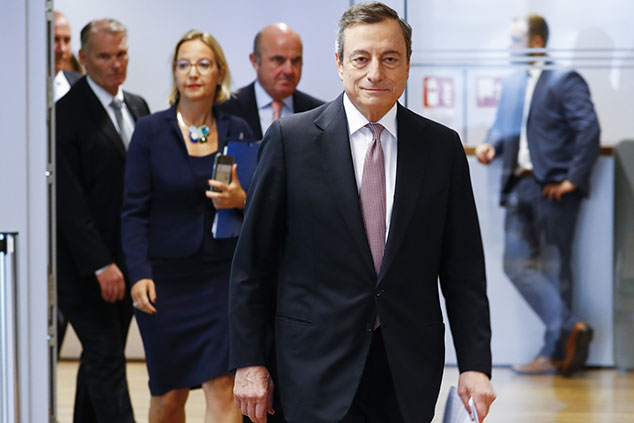
This article is taken from our FREE daily investment email Money Morning.
Every day, MoneyWeek’s executive editor John Stepek and guest contributors explain how current economic and political developments are affecting the markets and your wealth, and give you pointers on how you can profit.
A bit of exciting news before we get started today.
I mentioned in yesterday’s email that I was hoping to announce the appearance of a very special guest at the MoneyWeek Wealth Summit on 22 November.
Well, I’m pleased to be able to say that Andy Haldane, the Bank of England’s chief economist, will be joining us on the day to discuss, among other things, the future of money.
Given the extremely unusual – in many ways unique – financial and monetary environment we’re living in, the opportunity to hear directly from someone who has been working at the coalface of monetary policy for years is one not to be missed.
Book your ticket now. And if you’re a MoneyWeek subscriber, check the latest issue – which should be hitting your letter box any minute now – for your discount code (it’s in the brochure attached to the front cover).
Now to today’s topic. Which, coincidentally enough, is all about monetary policy.
Draghi to governments: please spend my money
Yesterday was Mario Draghi’s last chance to leave a lasting impact on eurozone monetary policy.
During his time as European Central Bank boss, he managed to convince markets that he wouldn’t let the euro implode on his watch. So he can tick that one off as “mission accomplished”.
What he had to do yesterday, was to give his incoming successor, Christine Lagarde, as much support as possible to enable her to maintain a “dovish” approach to monetary policy, and resist the more “hawkish” approach favoured by German central bankers and some of their compatriots.
And, to be honest, that seems to be what he’s done.
There has been some scepticism from commentators. Draghi cut interest rates from negative 0.4% to negative 0.5%, which was no more than expected. He also restarted quantitative easing (QE), but only at €20bn a month – markets had expected €30bn.
However, the devil is in the detail. And the most important detail is that he said that QE will continue until the eurozone’s inflation target is met and interest rates start rising. In other words, it’s QE for as long as it takes.
Now, some people have argued that this is not as big a deal as it looks. The ECB is only allowed to buy up to 33% of outstanding bonds, and it is likely to hit that ceiling in about a year.
However, with Draghi having set the precedent of ongoing QE, it is very hard to see eurozone central bankers running the risk of stopping it in the future, unless they are very clear that they have achieved their inflation target and that the market won’t collapse if they do so.
In effect, he’s set monetary policy on autopilot so that Lagarde (who is more politician than central banker) can let QE rumble on and spend the rest of her time trying to convince German politicians to spend more money.
And this really was Draghi’s parting message. He said that eurozone banks should stop moaning about negative interest rates and instead build better, more competitive businesses.
And he said that if politicians wanted negative interest rates to end, then they should use more fiscal policy (ie, more government spending), to get their economies moving, which would then put an end to the need for negative rates more quickly.
In effect, he’s practically begging them to take that €20bn a month and spend it on something.
Central banks can’t do what they’re being asked to do
You may or may not agree with any of these moves.
For my part, I’ve probably made this clear in the past, but I think that the way our entire financial system has become geared to the decisions of central banks is incredibly unhealthy and is undermining the efficient allocation of capital, which is the whole point of a free market system.
It’s also increasingly hard to see what we’re trying to achieve with current monetary policy. Central banks are being asked to fix problems that they really can’t do anything about.
The eurozone’s problems are structural – it’s a half-finished project that doesn’t have the political backing to do what’s necessary to reach the end stage. Draghi can patch over that but he can’t fix it.
However, no one is ready to face up to that as yet. So Draghi is the only show in town. And if you want to know if his approach worked or not, then I said yesterday that the market reaction is probably the thing to watch. And so far the reaction suggests that Draghi’s plan has indeed worked, at least for now.
I noted that we’d be looking for a rise in eurozone banking stocks (which have been the epicentre of recent market deflation fear), and a bounce in the euro (this is counterintuitive – you’d normally expect looser monetary policy to weaken the currency – but I’d suggest in this case it’s indicative of confidence that Draghi has managed to push back a potential blow up once again).
So far, eurozone bank stocks have ticked higher, as has the euro.
How long will this added confidence boost last? It’s hard to say. But if markets believe that Draghi has done enough to underwrite the eurozone system (again), and to prevent the hawks from taking over once he steps down, then it’s possible that this could mark a turning point – and that the market’s fear of deflation will once again start to reverse.